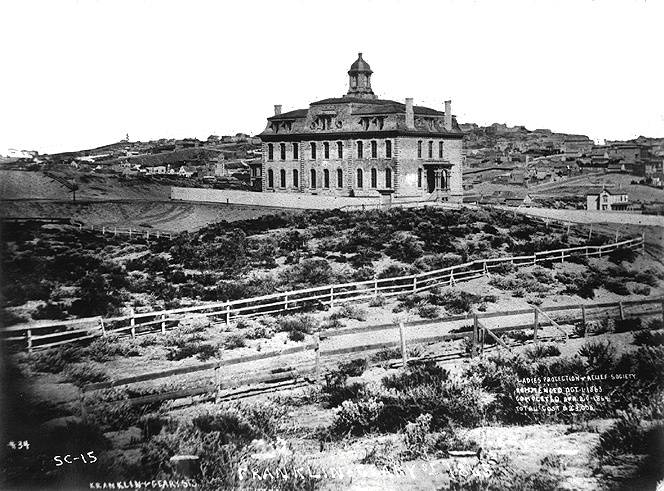San Francisco Orphan Asylum Society: Difference between revisions
m (Protected "San Francisco Orphan Asylum Society": finished essay [edit=sysop:move=sysop]) |
mNo edit summary |
||
| Line 18: | Line 18: | ||
On April 17, 1906, the San Francisco earthquake and fire destroyed much of the City. Everyone escaped from the orphanage unharmed. Because the building was located west of Van Ness, it was damaged, not destroyed. The repairs were complete by November, 1906. For a period of time, the displaced children resided at the State Normal School, (which would later become San Francisco State University) on the southern half of the property. The orphanage had leased this portion to the State of California. In 1919, because of the earthquake damage and age of the building, the Managers decided to sell the property and construct a new orphanage in another part of the City. The State of California purchased the property. The orphanage was razed. | On April 17, 1906, the San Francisco earthquake and fire destroyed much of the City. Everyone escaped from the orphanage unharmed. Because the building was located west of Van Ness, it was damaged, not destroyed. The repairs were complete by November, 1906. For a period of time, the displaced children resided at the State Normal School, (which would later become San Francisco State University) on the southern half of the property. The orphanage had leased this portion to the State of California. In 1919, because of the earthquake damage and age of the building, the Managers decided to sell the property and construct a new orphanage in another part of the City. The State of California purchased the property. The orphanage was razed. | ||
Revision as of 15:06, 18 January 2009
Historical Essay
by George Gomes
1865 view of Ladies Protection and Relief Society, bounded by today's Haight, Buchanan, Hermann and Laguna Streets.
Commenced Oct. 1, 1863 / Completed Aug. 20, 1864 / Total Cost: $23,000 is the text written on the 1865 photograph of the Ladies Protection and Relief Society in the Western Addition area.
San Francisco Orphan Asylum Society
The San Francisco Orphan Asylum Society (SFOA) was founded in 1851 by a group of ladies attending meetings hosted by the Reverend Albert Williams and his wife. The asylum was originally founded to help a group of siblings, aged 3 to 12 years, orphaned by cholera en route to San Francisco. In the early days, the SFOA Board of Managers was comprised of all women. For legal reasons, the Board of Managers appointed three gentlemen to hold property in trust for the SFOA. The first matron of the SFOA was Mrs. Wilson. The first on-call physician was Dr. Benjamin Coit. The orphanage opened on March 19, 1851 in a prefabricated cottage in Happy Valley, now known as the South of Market area surrounding Rincon Hill. The population of the orphanage grew as the Managers placed local children in need of aid. Most of the San Francisco children were not orphans, but from single parent homes. By 1852, there were 26 children in the orphanage and a new, larger home was needed.
The Board of Managers purchased land available through public auction. The property was considered remote and far beyond the city limits. Throughout San Francisco, the Board Managers solicited door-to-door donations to raise money to purchase the property and partially fund construction costs. For a purchase price of $100, a two block lot bounded by Haight, Buchanan, Hermann and Laguna Streets became the new site for the San Francisco Protestant Orphan Asylum. The site would remain home for the orphanage from 1854 to 1919. San Francisco legend has it that Haight and Waller Streets were named after Mrs. Haight and Mrs. Waller, who served on the SFOA Board.
The children moved into the new facility on March 22, 1854. The original building was a two-story dormitory-style structure. It was built of stone which was quarried from the site of the old San Francisco Mint. Spring Valley Water Company transported the stone free of charge. The children were schooled on site in the years from 1854 to 1897. After the home on Haight Street was built, the Managers raised money for the orphanage through annual “subscription” donations from local Protestant churches. Many prominent San Franciscans donated to the orphanage: H. H. Bancroft, Lillie H. Coit, Mrs. Crocker, James Flood, James Phelan, Mrs. Stanford, Levi Strauss, and Adolph Sutro. Throughout the years, local merchants and philanthropists sponsored outings for the orphans, including the Mid-Winter Fair of 1893, and the Pan-Pacific International Exposition of 1915. The number of children housed at the orphanage grew from two dozen to three hundred. From all accounts, Hayes Valley residents enjoyed having the children living in their neighborhood. The orphans socialized with the neighborhood children and it was not uncommon for them to play in the orphanage garden.
On April 17, 1906, the San Francisco earthquake and fire destroyed much of the City. Everyone escaped from the orphanage unharmed. Because the building was located west of Van Ness, it was damaged, not destroyed. The repairs were complete by November, 1906. For a period of time, the displaced children resided at the State Normal School, (which would later become San Francisco State University) on the southern half of the property. The orphanage had leased this portion to the State of California. In 1919, because of the earthquake damage and age of the building, the Managers decided to sell the property and construct a new orphanage in another part of the City. The State of California purchased the property. The orphanage was razed.

